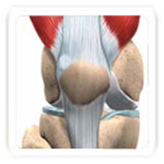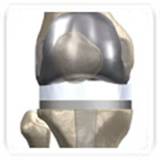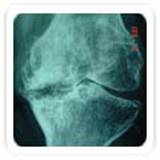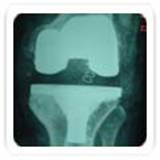- +91 9820036852
- sanjeev.jain@hiranandanihospital.org
- drsanjain@hotmail.com
Total Knee Replacement
Total knee replacement is one of the most commonly performed surgeries for knee osteoarthritis, or degenerative joint disease with an excellent result.
Total KNEE Replacement

Normal Knee Joint
The knee is made up of the lower end of the thigh bone (femur), which rotates on the upper end of the shin bone (tibia), and the knee cap (patella), which slides in a groove on the lower end of the femur. Large ligaments attach to the femur and tibia to provide stability. The long thigh muscles (quadriceps) give strength to the knee.
The joint surfaces where these three bones touch each other are covered with articular cartilage, a smooth substance that cushions the bones and enables them to move easily.
A thin, smooth tissue liner called the synovial membrane covers all remaining surfaces of the knee. This membrane releases a special fluid that lubricates the knee, reducing friction to nearly zero in a healthy knee. Normally, all of these components work in harmony. But disease or injury can disrupt this harmony, resulting in pain, muscle weakness and less function
Total Knee Replacement (TKR) or Total Knee Arthroplasty (TKA)
Total knee replacement is one of the most commonly performed surgeries for knee osteoarthritis, or degenerative joint disease with an excellent result.
In knee replacement damaged cartilage or surfaces of the joint is replaced by high-grade metal and plastic material. Knee replacement completely relieves pain, improve quality of life and allow the patient to perform all routine normal activities.




When to consider Total Knee Replacement
The decision whether to have total knee replacement surgery should be a co-operative one between you, your family, and me. Following criteria would help to decide about this:
- Severe knee pain that limits everyday activities.
- Moderate or severe knee pain while resting, either day or night.
- Failure to obtain pain relief from non-steroidal anti-inflammatory drugs.
- Inability to tolerate or complications from pain medications.
- Failure to substantially improve with other treatments such as cortisone injections, physical therapy, or other surgeries.
- Knee stiffness--inability to bend and straighten your knee.
- Deformity – a bowing in or out of the knee.
- Chronic knee inflammation and swelling that doesn't improve with rest or medications.
Ideal age for Total Knee Replacement
Most patients who undergo total knee replacement are aged between 60 to 90 years, but I evaluate patients individually. Recommendations for surgery are based on a patient's pain and disability, not age. Total knee replacements have been performed successfully at all ages, from the young teenager with juvenile arthritis to the elderly patient with degenerative arthritis.
Material used for Knee Replacement
Many different types of designs and materials are currently used in total knee replacement surgery. Nearly all of them consist of four components: the femoral component (made of a highly polished strong metal – cobalt chrome molybdenum), the tibial component (made of a metal – highly polished cobalt chrome molybdenum or titanium), tibial plastic insert (made of a durable plastic UHMWPE – Ultra High Molecular Weight Polyethylene, often held in a metaltibial tray), and the patellar component (also plastic)